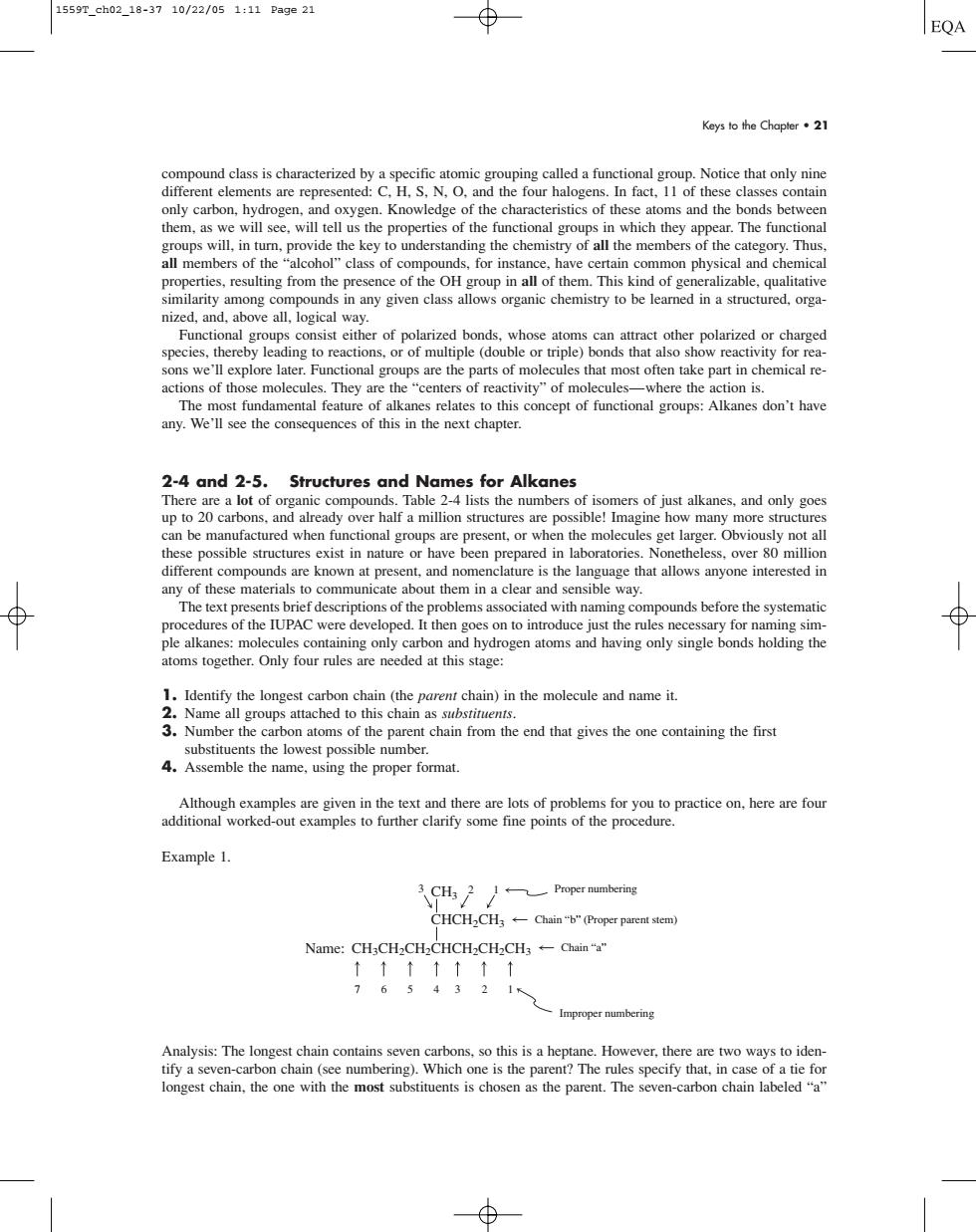正在加载图片...

1559T_ch02_18-3710/22/051:11Page21 EQA Keys to the Chapler·21 und class is char only carbon,hydrogen,and oxygen.Knowledge of the characteristics of these atoms and the bonds betweer hem,as w s the prop almembers of compounds,for instan.have certain common physical and chemica lting from the presence lizable,qualitativ nized.and.above all.logical wav structured,orga polarizedor charged ar the parts of molecules that most often take part in chemical re actions of those molecules.They are the"centers of reactivity"of molecules- -where the a ion is. any. of functional goupAkon'have 2-4and2-5. Structures and Names for Alkanes of c r half a million wo se possible xist in nature or been pared heless.o 80 mi any of these materials to communicate about them in a clear and sensible wav The text presents b ief descriptions of the problems with naming compounds before the systemai PAC ped.I tnen s on to single nds hol the atoms together.Only four rules are needed at this stage: oups attached to this chain as nchain)in the molecule and name it. 3.Nur r the arbon atoms o the parent chain from the end that gives the one containing the first 4.Assemble the name,using the proper format. ahteehc Example】 3CH3 Proper numbering CHCH2CH3+Chain"b"(Proper parent stem) Name:CH,CH2CHaCHCH2CH2CH3-Chain" 765 321 Improper numbering st chain so this is a h Ho re two ways to ider s specify that,in case of a tie fo Keys to the Chapter • 21 compound class is characterized by a specific atomic grouping called a functional group. Notice that only nine different elements are represented: C, H, S, N, O, and the four halogens. In fact, 11 of these classes contain only carbon, hydrogen, and oxygen. Knowledge of the characteristics of these atoms and the bonds between them, as we will see, will tell us the properties of the functional groups in which they appear. The functional groups will, in turn, provide the key to understanding the chemistry of all the members of the category. Thus, all members of the “alcohol” class of compounds, for instance, have certain common physical and chemical properties, resulting from the presence of the OH group in all of them. This kind of generalizable, qualitative similarity among compounds in any given class allows organic chemistry to be learned in a structured, organized, and, above all, logical way. Functional groups consist either of polarized bonds, whose atoms can attract other polarized or charged species, thereby leading to reactions, or of multiple (double or triple) bonds that also show reactivity for reasons we’ll explore later. Functional groups are the parts of molecules that most often take part in chemical reactions of those molecules. They are the “centers of reactivity” of molecules—where the action is. The most fundamental feature of alkanes relates to this concept of functional groups: Alkanes don’t have any. We’ll see the consequences of this in the next chapter. 2-4 and 2-5. Structures and Names for Alkanes There are a lot of organic compounds. Table 2-4 lists the numbers of isomers of just alkanes, and only goes up to 20 carbons, and already over half a million structures are possible! Imagine how many more structures can be manufactured when functional groups are present, or when the molecules get larger. Obviously not all these possible structures exist in nature or have been prepared in laboratories. Nonetheless, over 80 million different compounds are known at present, and nomenclature is the language that allows anyone interested in any of these materials to communicate about them in a clear and sensible way. The text presents brief descriptions of the problems associated with naming compounds before the systematic procedures of the IUPAC were developed. It then goes on to introduce just the rules necessary for naming simple alkanes: molecules containing only carbon and hydrogen atoms and having only single bonds holding the atoms together. Only four rules are needed at this stage: 1. Identify the longest carbon chain (the parent chain) in the molecule and name it. 2. Name all groups attached to this chain as substituents. 3. Number the carbon atoms of the parent chain from the end that gives the one containing the first substituents the lowest possible number. 4. Assemble the name, using the proper format. Although examples are given in the text and there are lots of problems for you to practice on, here are four additional worked-out examples to further clarify some fine points of the procedure. Example 1. Analysis: The longest chain contains seven carbons, so this is a heptane. However, there are two ways to identify a seven-carbon chain (see numbering). Which one is the parent? The rules specify that, in case of a tie for longest chain, the one with the most substituents is chosen as the parent. The seven-carbon chain labeled “a” CH3CH2CH2CHCH2CH2CH3 CHCH2CH3 CH3 Name: 7 6 5 4 3 2 1 3 2 1 Chain “b” (Proper parent stem) Improper numbering Chain “a” Proper numbering 1559T_ch02_18-37 10/22/05 1:11 Page 21